Impact of Neighborhood Urban Morphologies on Walkability Using Spatial Multi-Criteria Analysis
Abstract
:1. Introduction
2. Literature Review
2.1. Walkability as a Concept
2.2. Urban Morphology
2.3. Factors Impacting Urban Morphology
2.4. Intertwining Factors between Walkability and Urban Morphology
3. Materials and Methods
3.1. Methodology and Data Sources
- First, the research used qualitative analysis to identify the criteria and indicators that are important to assess walkability and would also be attained for the selected case study. Considering the data availability, the authors must drop some indicators from the analysis. Table 3 summarizes the criteria and indicators that were finally adopted for this study.
- Second, using the study area boundaries for the selected neighborhoods, land-use data were reclassified into 23 classes. Moreover, to extract the service layer, 12 types of services are also reclassified to be used for calculations of the densities and distance concept to compare the urban morphology for the four selected areas.
- Third, as given in Table 3, 12 indicators were calculated spatially in ArcGIS to measure the walkability index across the four study areas using spatial multi-criteria analysis (SMCA). The following sub-sections show details of the calculations and formulas for each indicator.
- At the final stage, the results were aggregated and mapped, revealing the final walkability index values for the four study areas. After the initial mapping and spatial analysis were completed, direct observations were carried out by the authors to better understand the final outcome.
3.2. Data Preparation and Pre-Processing Procedures
3.2.1. Reclassification of Services and Land-Use Classes
- Infrastructure and Utilities
- Commercial (i.e., banks, shops, stores, supermarkets, restaurants, shopping centers)
- Healthcare (i.e., hospitals, clinics, healthcare centers, etc.)
- Educational (i.e., schools, universities, faculties, educational centers, kinder gardens, etc.)
- Religious (i.e., Churches, Mosques, Islamic complexes, Christian centers, etc.)
- Cultural (i.e., cultural theatres, museums, cultural centers, libraries, etc.)
- Governmental and administrative (i.e., postal office, Police stations, etc.)
- Sports services (i.e., stadiums, sports clubs, gyms, etc.)
- Recreational (i.e., clubs, cinemas, recreational centers, etc.)
- Industrial (i.e., factories, clothes factories, workshops, etc.)
- Social (i.e., orphanage centers, social services, social halls, etc.)
- Touristic (i.e., hotels, motels, touristic compounds, etc.)
3.2.2. The Spatial Unit for Calculations
3.3. SMCA and Geoprocessing Model
3.3.1. Computing the Individual Indicators
- LUd (i) is the land-use diversity in the area of analysis i,
- Lui = the land use class (1, 2, 3, 4, …, n) in the area of analysis i,
- QLui = the ratio of the area within the area of analysis i,
- n = the total number of the different land uses in the area of analysis i,
- SLui = total area of land use j within the area of analysis i,
- Si = total area of the area of analysis i.
- MI is the mixedness index for the area of analysis i,
- Sc shows the sum of the total area of other land uses within the area of analysis i
- Sr is the sum of the total land area under residential land use within the area of analysis i.
3.3.2. Standardization of Indicators
3.3.3. Assign Weights to Indicators
3.3.4. Computing the Composite Walkability Index
- Wi is the multiplication result of the weights of all indicators or criteria,
- Ri the standardized values of each pixel in the map of the indicator or criterion,
- n is the total number of the indicator or criterion.
4. The Study Area
5. Results
6. Discussion
7. Conclusions
Author Contributions
Funding
Data Availability Statement
Conflicts of Interest
References
- Tuominen, A.; Sundqvist-Andberg, H.; Aittasalo, M.; Silonsaari, J.; Kiviluoto, K.; Tapio, P. Building transformative capacity towards active sustainable transport in urban areas–Experiences from local actions in Finland. Case Stud. Transp. Policy 2022, 10, 1034–1044. [Google Scholar] [CrossRef]
- Liu, X.; Dijk, M.; Colombo, C. Improving multilevel policy mixes for sustainable urban mobility transition. Environ. Innov. Soc. Transit. 2024, 50, 100808. [Google Scholar] [CrossRef]
- Kiviluoto, K.; Tapio, P.; Tuominen, A.; Lyytimäki, J.; Ahokas, I.; Silonsaari, J.; Schwanen, T. Towards sustainable mobility–Transformative scenarios for 2034. Transp. Res. Interdiscip. Perspect. 2022, 16, 100690. [Google Scholar] [CrossRef]
- Bedoya-Maya, F.; Calatayud, A.; Mejía, V.G. Estimating the effect of road congestion on air quality in Latin America. Transp. Res. Part D Transp. Environ. 2022, 113, 103510. [Google Scholar] [CrossRef]
- ITF. Improving the Quality of Walking and Cycling in Cities: Summary and Conclusions; OECD Publishing: Paris, France, 2024; 70p, Available online: https://itf-oecd.org/improving-quality-walking-cycling-cities (accessed on 3 March 2024).
- Gorrini, A.; Presicce, D.; Messa, F.; Choubassi, R. Walkability for children in Bologna: Beyond the 15-minute city framework. J. Urban Mobil. 2023, 3, 100052. [Google Scholar] [CrossRef]
- Jackson, R.J.; Kochtitzky, C. Creating A Healthy Environment: The Impact of the Built Environment on Public Health. Director 2010, 20, 78–80. [Google Scholar] [CrossRef] [PubMed]
- Lyons, G. Walking as a service–Does it have legs? Transp. Res. Part A Policy Pract. 2020, 137, 271–284. [Google Scholar] [CrossRef]
- Gehl, J. Cities for People; Island Press: Washington, DC, USA, 2010; pp. 1–269. [Google Scholar]
- Stein, M.; Nitschke, L.; Trost, L.; Dirschauer, A.; Deffner, J. Impacts of Commuting Practices on Social Sustainability and Sustainable Mobility. Sustainability 2022, 14, 4469. [Google Scholar] [CrossRef]
- Baobeid, A.; Koç, M.; Al-Ghamdi, S.G. Walkability and Its Relationships With Health, Sustainability, and Livability: Elements of Physical Environment and Evaluation Frameworks. Front. Built Environ. 2021, 7, 721218. [Google Scholar] [CrossRef]
- Donnelly, J.E.; Hillman, C.H.; Castelli, D.; Etnier, J.L.; Lee, S.; Tomporowski, P.; Lambourne, K.; Szabo-Reed, A.N. Physical activity, fitness, cognitive function, and academic achievement in children: A systematic review. Med. Sci. Sports Exerc. 2017, 48, 1197. [Google Scholar] [CrossRef]
- Rothman, L.; Hagel, B.; Howard, A.; Cloutier, M.S.; Macpherson, A.; Aguirre, A.N.; McCormack, G.R.; Fuselli, P.; Buliung, R.; HubkaRao, T.; et al. Active school transportation and the built environment across Canadian cities: Findings from the child active transportation safety and the environment (CHASE) study. Prev. Med. 2021, 146, 106470. [Google Scholar] [CrossRef] [PubMed]
- Ibrahim, S.M.S.Z. The making of creative cities: Exploring the role of sustainable urban mobility (SUM). In Handbook of Research on Creative Cities and Advanced Models for Knowledge-Based Urban Development; IGI Global: Hershey, PA, USA, 2020; pp. 173–196. [Google Scholar] [CrossRef]
- Abdel-Razek, S.A. Governance and SDGs in smart cities context. In Smart Cities and the un SDGs; Elsevier: Amsterdam, The Netherlands, 2021; pp. 61–70. [Google Scholar]
- Biehl, A.; Stathopoulos, A. Investigating the interconnectedness of active transportation and public transit usage as a primer for Mobility-as-a-Service adoption and deployment. J. Transp. Health 2020, 18, 1847537. [Google Scholar] [CrossRef]
- Dovey, K.; Pafka, E. What is walkability? The urban DMA. Urban Stud. 2020, 57, 93–108. [Google Scholar] [CrossRef]
- Visvizi, A.; Abdel-Razek, S.A.; Wosiek, R.; Malik, R. Conceptualizing Walking and Walkability in the Smart City through a Model Composite w2 Smart City Utility Index. Energies 2021, 14, 8193. [Google Scholar] [CrossRef]
- Shields, R.; da Silva, E.J.G.; Lima, T.L.E.; Osorio, N. Walkability: A review of trends. J. Urban. Int. Res. Placemaking Urban Sustain. 2023, 16, 19–41. [Google Scholar] [CrossRef]
- Ren, G.; Zhou, Z.; Wang, W.; Zhang, Y.; Wang, W. Crossing behaviors of pedestrians at signalized intersections: Observational study and survey in China. Transp. Res. Rec. 2011, 2264, 65–73. [Google Scholar] [CrossRef]
- Singh, R. Factors Affecting Walkability of Neighborhoods. Procedia-Soc. Behav. Sci. 2016, 216, 643–654. [Google Scholar] [CrossRef]
- Ewing, R.; Handy, S. Measuring the Unmeasurable: Urban Design Qualities Related to Walkability. J. Urban Des. 2009, 14, 65–84. [Google Scholar] [CrossRef]
- Özbil, A.; Yeşiltepe, D.; Argin, G. Modeling walkability: The effects of street design, street-network configuration and land-use on pedestrian movement. A/Z ITU J. Fac. Archit. 2015, 12, 189–207. [Google Scholar]
- Morphology, A.C.U. Urban Morphology/Urban Form. In the Wiley Blackwell Encyclopedia of Urban and Regional Studies; Wiley: Hoboken, NJ, USA, 2019; pp. 1–6. [Google Scholar] [CrossRef]
- Barke, M. The importance of urban form as an object of study. In the Urban Book Series; Spring: Berlin/Heidelberg, Germany, 2018; pp. 11–30. [Google Scholar] [CrossRef]
- Guastella, G.; Oueslati, W.; Pareglio, S. Patterns of urban spatial expansion in European Cities. Sustainability 2019, 11, 2247. [Google Scholar] [CrossRef]
- Inusa, Y.J.; Toe, D.H.C.; Yong, K.W. Urban Form and the Role of Urban Morphological Characters in Town-Plan Regionalization: A Systematic Review. Archit. Urban Plan. 2022, 18, 43–56. [Google Scholar] [CrossRef]
- Chen, W.; Noah, A.; Biljecki, F. Classification of Urban Morphology with Deep Learning: Application on Urban Vitality. Comput. Environ. Urban Syst. 2021, 90, 101706. [Google Scholar] [CrossRef]
- Boeing, G. Spatial Information and the Legibility of Urban form: Big Data in Urban Morphology. Int. J. Inf. Manag. 2021, 56, 102013. [Google Scholar] [CrossRef]
- Rosu, L.I.; Oiste, A.M. Urban Landscape Patterns of Iași City. Analysing City Relations Between Urban Land use, Topography and Inhabitants Pressure Upon Urban Morphology. Bull. UASVMAgriculture 2014, 71, 96–104. [Google Scholar] [CrossRef]
- Oyugi, M.O. Is Urban Morphology a Panacea or a Peril to Sustainability? Archit. Res. 2018, 8, 92–102. [Google Scholar]
- Amirtham, L.R.; Horrison, E.; Rajkumar, S. Impact of urban morphology on Microclimatic conditions and outdoor thermal comfort-A study in mixed residential neighbourhood of Chennai, India. In Proceedings of the ICUC9-9th International Conference on Urban Climate jointly with 12th Symposium on the Urban Environment Urban Climate Monitoring Networks Based on LCZ Concept, Toulouse, France, 20–24 July 2015. [Google Scholar]
- Larkham, P.J. Assessing a quarter-century of Urban Morphology. Urban Morphol. 2022, 26, 173–188. [Google Scholar] [CrossRef]
- Raina, S.; Madapur, B.; Raj, M.P. Urban Morphology–Different Attributes that Shape Urban Form. 2018, 1–24. Proceedings of 7th International Conference on Research in Science and Technology, Munich, Germany, 19–21 October 2018. [Google Scholar] [CrossRef]
- Williams, K. Urban Form and Infrastructure: A Morphological Review. Future of Cities: Working Paper; 58p, 2014. Available online: https://www.gov.uk/government/uploads/system/uploads/attachment_data/file/324161/14-808-urban-form-and-infrastructure-1.pdf (accessed on 12 November 2023).
- Rahman, M. (Ed.) Handbook of Waterfront Cities and Urbanism, 1st ed.; Routledge: London, UK, 2022. [Google Scholar]
- Esposito, A.; Grulois, M.; Pappaccogli, G.; Palusci, O.; Donateo, A.; Salizzoni, P.; Buccolieri, R. On the Calculation of Urban Morphological Parameters Using GIS: An Application to Italian Cities. Atmosphere 2023, 14, 329. [Google Scholar] [CrossRef]
- Guo, F.; Schlink, U.; Wu, W.; Mohamdeen, A. Differences in Urban Morphology between 77 Cities in China and Europe. Remote Sens. 2022, 14, 5462. [Google Scholar] [CrossRef]
- Karimimoshaver, M.; Khalvandi, R.; Khalvandi, M. The effect of urban morphology on heat accumulation in urban street canyons and mitigation approach. Sustain. Cities Soc. 2021, 73, 103127. [Google Scholar] [CrossRef]
- Łaszkiewicz, E.; Wolff, M.; Andersson, E.; Kronenberg, J.; Barton, D.N.; Haase, D.; McPhearson, T. Greenery in urban morphology: A comparative analysis of differences in urban green space accessibility for various urban structures across European cities. Ecol. Soc. 2022, 27, 3. [Google Scholar] [CrossRef]
- Pattacini, L. Climate and urban form. Urban Des. Int. 2012, 17, 106–114. [Google Scholar] [CrossRef]
- Mohsen, H.; Ahmadieh, H. Correlating walkability and urban morphology on Woman’s health using spatial statistical analysis: A comparative study of two neighborhoods in Beirut. Alex. Eng. J. 2019, 58, 945–955. [Google Scholar] [CrossRef]
- Ahmed, K.G.; Alipour, S.M.H. More dense but less walkable: The impact of macroscale walkability indicators on recent designs of emirati neighborhoods. City Territ. Archit. 2021, 8, 1–26. [Google Scholar] [CrossRef]
- Comer, D.; Greene, J.S. The development and application of a land use diversity index for Oklahoma City, OK. Appl. Geogr. 2015, 60, 46–57. [Google Scholar] [CrossRef]
- Cervero, R.; Kockelman, K. Travel Demand and the 3Ds: Density, Diversity, and Design. Transp. Res. Part D Transp. Environ. 1997, 2, 199–219. [Google Scholar] [CrossRef]
- Zhao, Y.; Lin, Q.; Ke, S.; Yu, Y. Impact of land use on bicycle usage: A big data-based spatial approach to inform transport planning. J. Transp. Land Use 2020, 13, 299–316. [Google Scholar] [CrossRef]
- Boakye, K.; Bovbjerg, M.; Schuna, J., Jr.; Branscum, A.; Mat-Nasir, N.; Bahonar, A.; Hystad, P. Perceived built environment characteristics associated with walking and cycling across 355 communities in 21 countries. Cities 2023, 132, 104102. [Google Scholar] [CrossRef]
- Ibrahim, S.M.; Ayad, H.M.; Turki, E.A.; Saadallah, D.M. Measuring Transit-Oriented Development (TOD) levels: Prioritize potential areas for TOD in Alexandria, Egypt using GIS-Spatial Multi-Criteria based model. Alex. Eng. J. 2023, 67, 241–255. [Google Scholar] [CrossRef]
- Talen, E.; Compact, J.K. Walkable, Diverse Neighborhoods:Assessing Effects on Residents. Hous. Policy Debate 2014, 24, 717–750. [Google Scholar] [CrossRef]
- Caselli, B.; Carra, M.; Rossetti, S.; Zazzi, M. From urban planning techniques to 15-minute neighbourhoods. A theoretical framework and GIS-based analysis of pedestrian accessibility to public services. Eur. Transp. Trasp. Eur. 2021, 85, 1–15. [Google Scholar] [CrossRef]
- Koljensic, P. Analysis of 15-Minute City Index Regarding Spatial and Sociodemographic Attributes: Based on a Case Study of Amsterdam. Diploma Thesis, Tongji University Shanghai, Shanghai, China, 2022. Available online: https://repositum.tuwien.at/handle/20.500.12708/136512 (accessed on 12 November 2023).
- Fard, P. Measuring Transit Oriented Development (TOD): Implementing a GIS-Based Analytical Tool for Measuring Existing (TOD) Levels; University of Twente, Faculty of Geo-Information Science and Earth Observation (ITC): Enschede, The Netherlands, 2013. [Google Scholar]
- Lukman, A. Development and Implementation of a Transit-Oriented Development (TOD) Index around the Current Transit Nodes; University of Twente, Faculty of Geo-Information Science and Earth Observation (ITC): Enschede, The Netherlands, 2014. [Google Scholar]
- Ewing, R.; Cervero, R. Travel and the Built Environment: A Meta-Analysis. J. Am. Plan. Assoc. 2010, 76, 265–294. [Google Scholar] [CrossRef]
- PopWorld. Available online: www.popworld.com (accessed on 13 January 2024).
- Hasan, M.M.; Oh, J.S.; Kwigizile, V. Exploring the trend of walkability measures by applying hierarchical clustering technique. J. Transp. Health 2021, 22, 101241. [Google Scholar] [CrossRef]
- Brownson, R.C.; Hoehner, C.M.; Day, K.; Forsyth, A.; Sallis, J.F. Measuring the Built Environment for Physical Activity. State of the Science. Am. J. Prev. Med. 2009, 36, S99–S123.e12. [Google Scholar] [CrossRef]
- Thayer, T.C.; Gilliland, S.J.; Measures, G.A.U.W. Cautions, and Associations with Active and Public Transportation across Canada Graduate Program in Geography. 2016. Available online: http://ir.lib.uwo.ca/etd (accessed on 16 November 2023).
- Coffee, N.T. Constructing an Objective Index of Walkability. Ph.D. Thesis, The University of Adelaide, Adelaide, Australia, 2005. [Google Scholar]
- Mitchell, A. ESRI Guide to GIS Analysis: Vol 2. Spatial Measurements and Statistics 2; ESRI: Redlands, CA, USA, 2009. [Google Scholar]
- Akinci, Z.S.; Delclòs-Alió, X.; Vich, G.; Salvo, D.; Ibarluzea, J.; Miralles-Guasch, C. How different are objective operationalizations of walkability for older adults compared to the general population? A systematic review. BMC Geriatr. 2022, 22, 673. [Google Scholar] [CrossRef] [PubMed]
- Singh, Y.; He, P.; Flacke, J.; Maarseveen, M. Measuring (TOD) over a region using GIS based Multiple-Criteria Assessment Tools. SPA J. Sch. Plan. Archit. 2015, 19, 1–22. [Google Scholar]
- van Eck, J.R.; Koomen, E. Characterising urban concentration and land-use diversity in simulations of future land use. Ann. Reg. Sci. 2008, 42, 123–140. [Google Scholar] [CrossRef]
- Zhang, Y.; Guindon, B. Using satellite remote sensing to survey transport-related urban sustainability. Int. J. Appl. Earth Obs. Geoinf. 2006, 8, 149–164. [Google Scholar] [CrossRef]
- Singh, Y.J.; Lukman, A.; Flacke, J.; Zuidgeest, M.; Van Maarseveen, M.F.A.M. Measuring TOD around transit nodes-Towards TOD policy. Transp. Policy 2017, 56, 96–111. [Google Scholar] [CrossRef]
- Singh, Y.J.; Flacke, J.; Zuidgeest, M.; Van Maarseveen, M.F.A.M. Planning for Transit Oriented Development (TOD) Using a TOD Index Gender Gap in Cities View Project Participatory Modelling to Support Policy Making in Social-Ecological Systems View project. January 2015. Available online: https://www.researchgate.net/publication/290432243 (accessed on 16 April 2024).
- CC. A. for P. M. and Statistics, CAPMAS. 2023. Available online: https://www.capmas.gov.eg/ (accessed on 20 September 2023).
- Strategic Urban Plan (SUP) Alexandria 2032—Phase one: Detailed City Profile, Volume 2a, General Organization for Physical Planning (GOPP), (June 2014), p. 116. Available online: https://www.as-p.com/projects/general-strategic-master-plan-alexandria-2032-184 (accessed on 14 December 2023).
- Smith, R.; Baker, S.; Sharlene, S. Street Design: Part 1-Complete Streets: Public Roads, July/August 2010; p. 3, Federal Highway Administration. Available online: https://www.fhwa.dot.gov/publications/publicroads/10julaug/03.cfm (accessed on 23 February 2024).
- Elsawy, A.A.; Ayad, H.M.; Saadallah, D. Assessing livability of residential streets–Case study: El-Attarin, Alexandria, Egypt. Alex. Eng. J. 2019, 58, 745–755. [Google Scholar] [CrossRef]
- Forsyth, A.; Oakes, J.M.; Schmitz, K.H.; Hearst, M. Does residential density increase walking and other physical activity? Urban Stud. 2007, 44, 679–697. [Google Scholar] [CrossRef]
- Motomura, M.C.N.; da Fontoura, L.C.; Kanashiro, M. Understanding walkable areas: Applicability and analysis of a walkability index in a Brazilian city. Ambient. Construído 2018, 18, 413–425. [Google Scholar] [CrossRef]
- Forsyth, A.; Hearst, M.; Oakes, J.M.; Schmitz, K.H. Design and destinations: Factors influencing walking and total physical activity. Urban Stud. 2008, 45, 1973–1996. [Google Scholar] [CrossRef]
- Wei, Y.D.; Xiao, W.; Wen, M.; Walkability, R.W. Land use and physical activity. Sustainability 2016, 8, 65. [Google Scholar] [CrossRef]
- Foundation, T.P.; Frank, K.; Syntax, S.; SAssiociates, G. “Walkability and Mixed Use: Making Valuable and Healthy Communities,” East Aryshire. [Online]. Available online: https://www.knightfrank.be/research/walkability-and-mixed-use-making-valuable-and-healthy-communities-7667.aspx (accessed on 22 March 2024).
- Choi, Y.; Lee, H. Geographic Information System Based Analysis on Walkability of Commercial Streets at Growing Stage. In Proceedings of the 28th CAADRIA Conference, Ahmedabad, India, 18–24 March 2023; pp. 575–584. [Google Scholar] [CrossRef]
- Sofwan, M.; Tanjung, M.H. Evaluation Study Of Walkability Index In Central Business District (CBD) Area, Pekanbaru City. J. Geosci. Eng. Environ. Technol. 2020, 5, 175–185. [Google Scholar] [CrossRef]
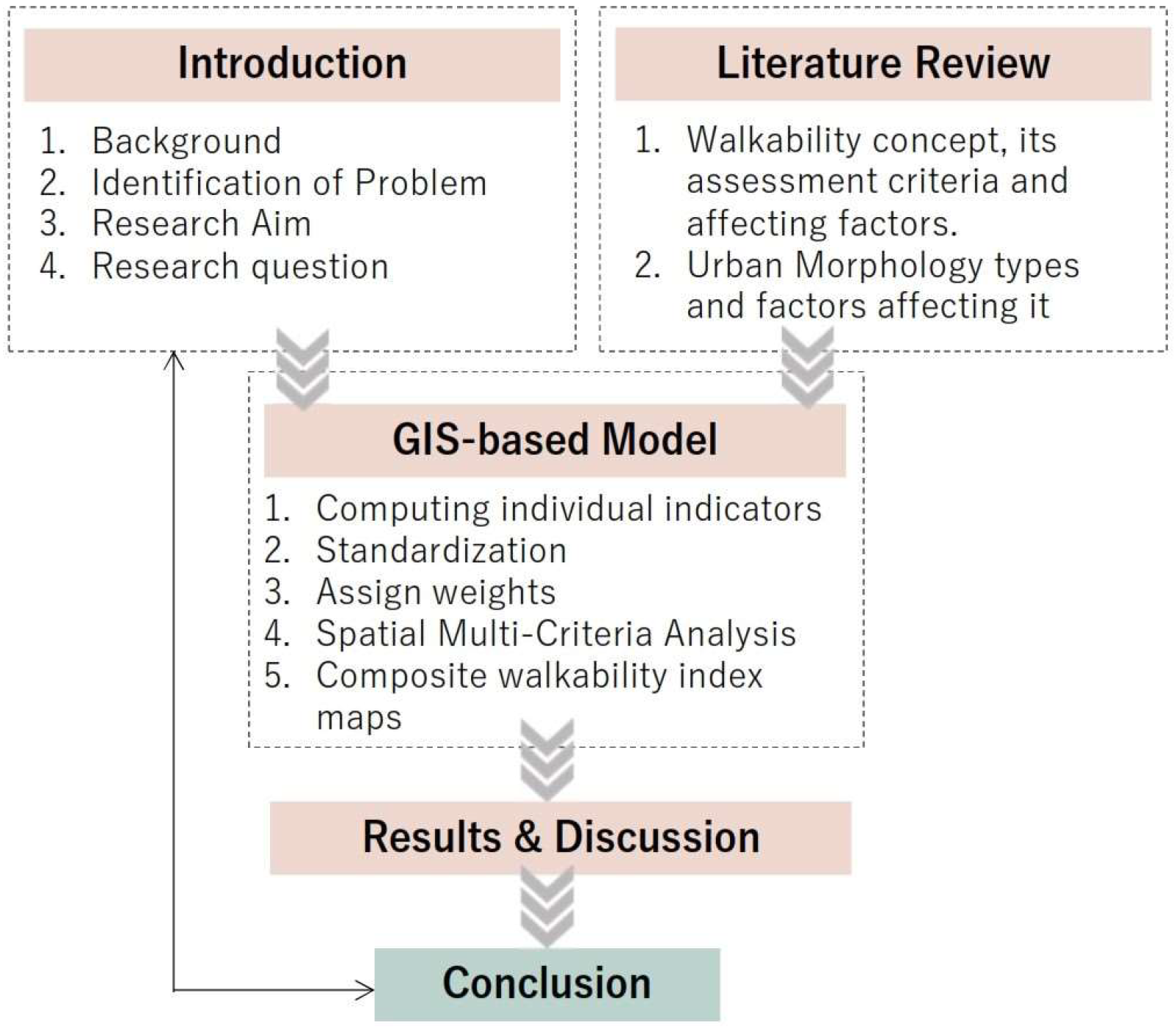
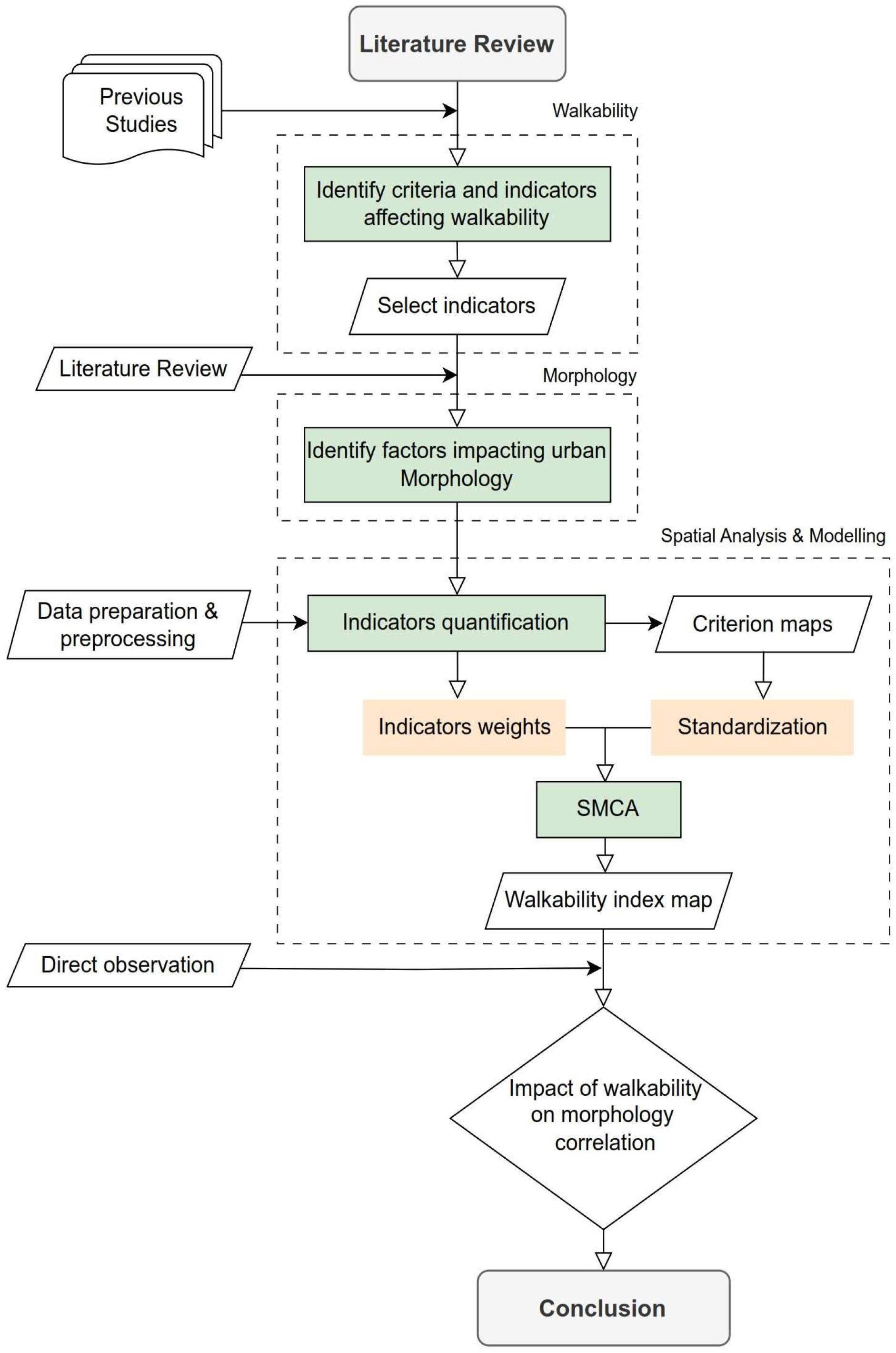
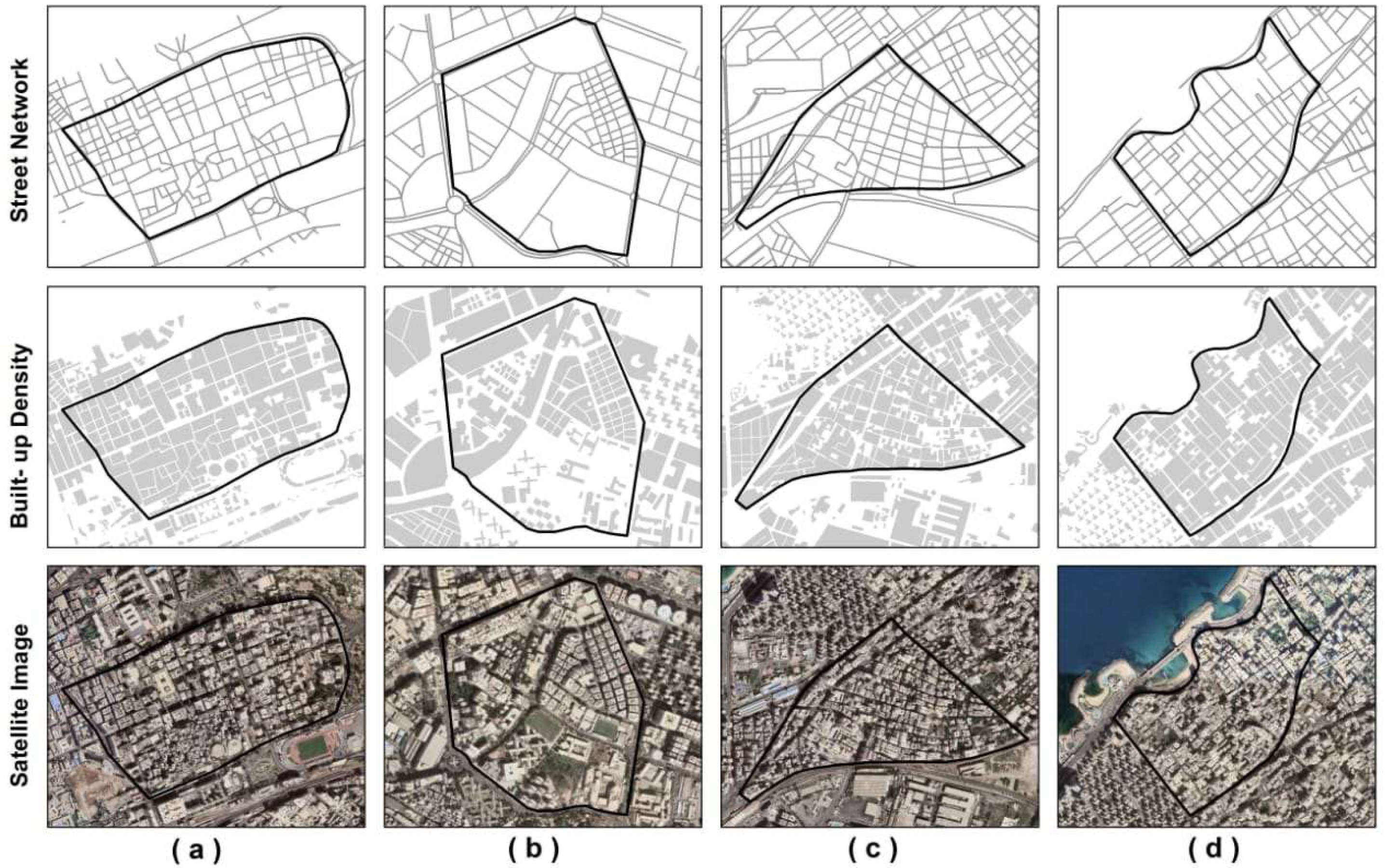


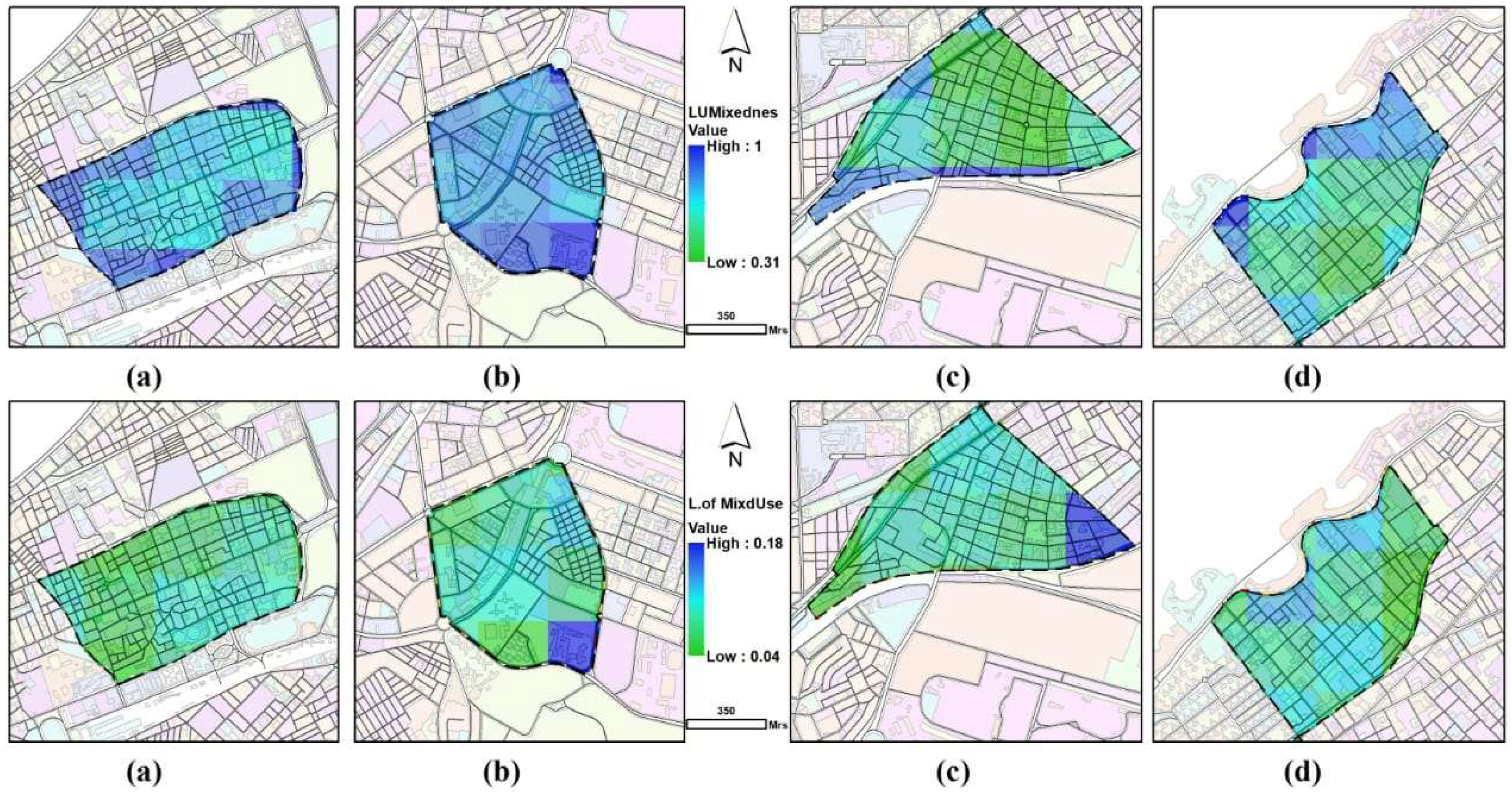
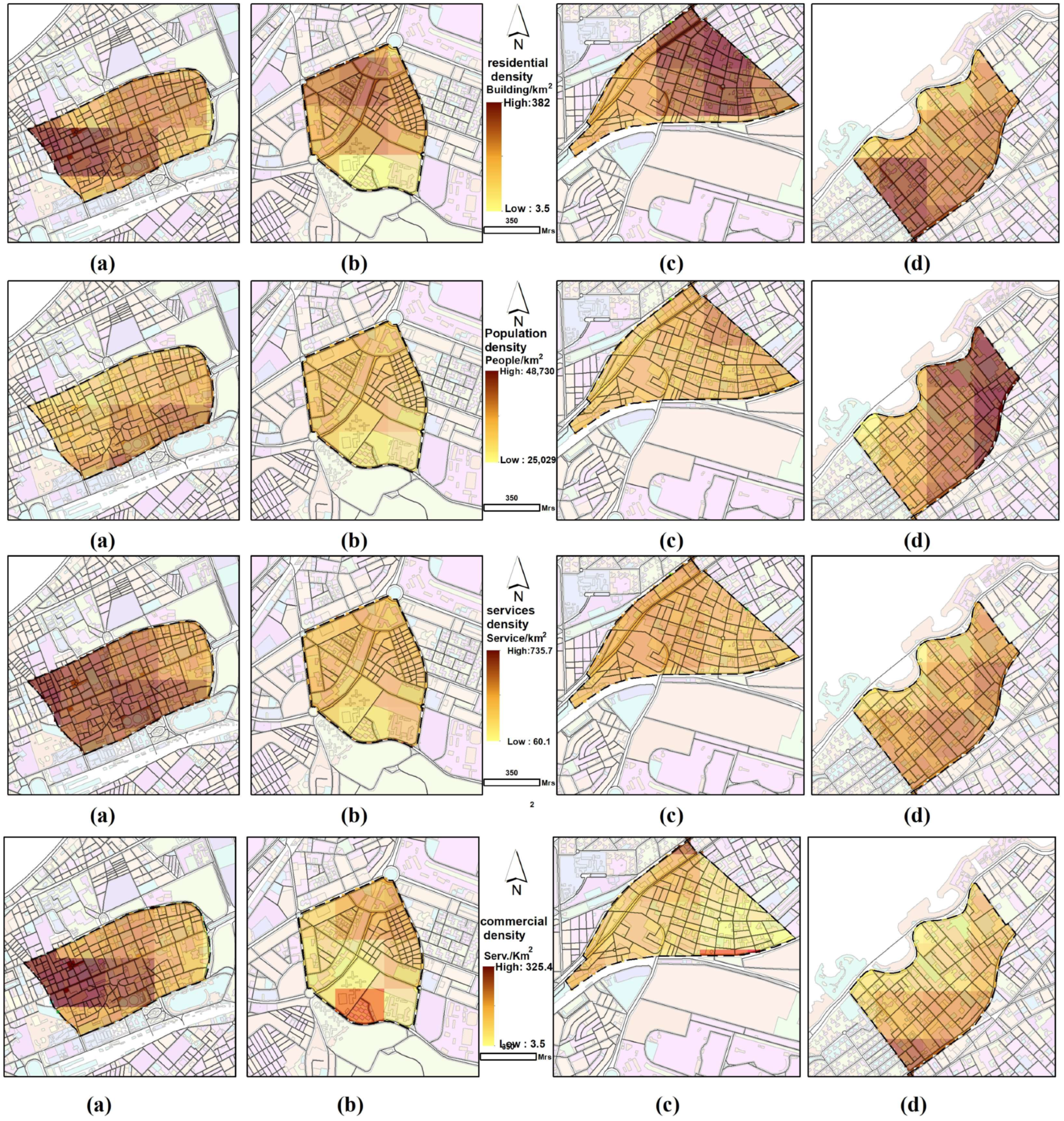
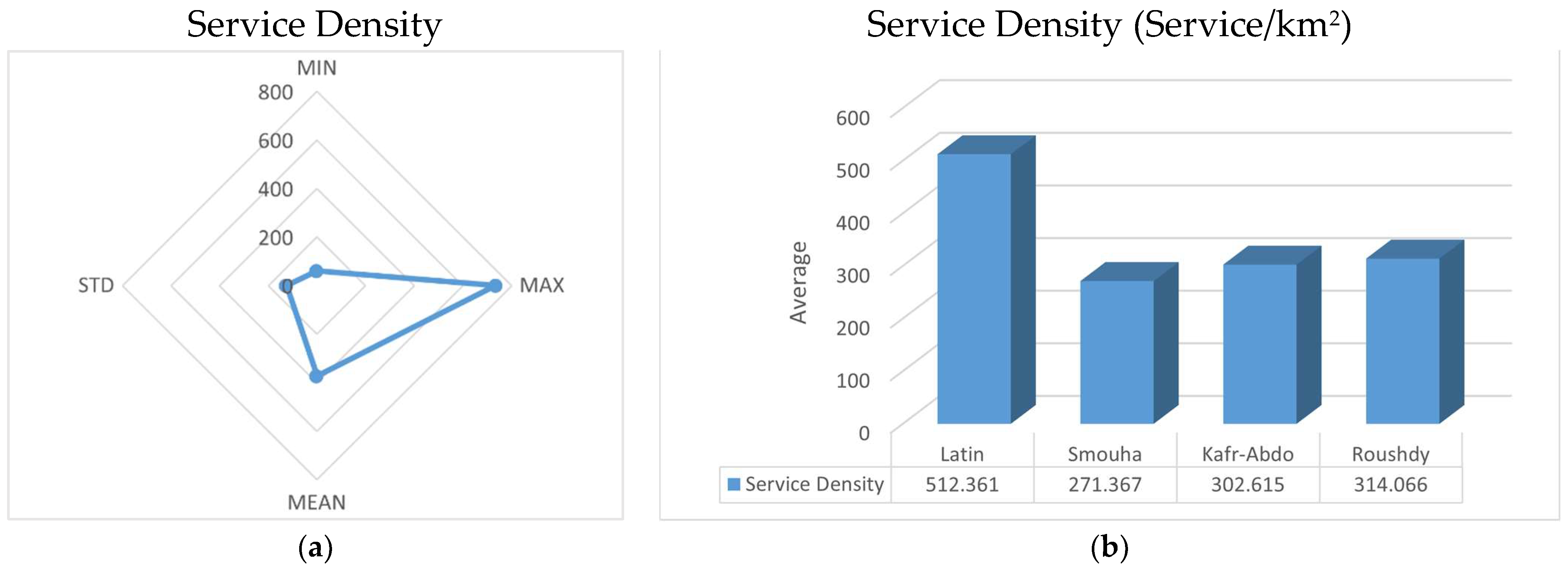
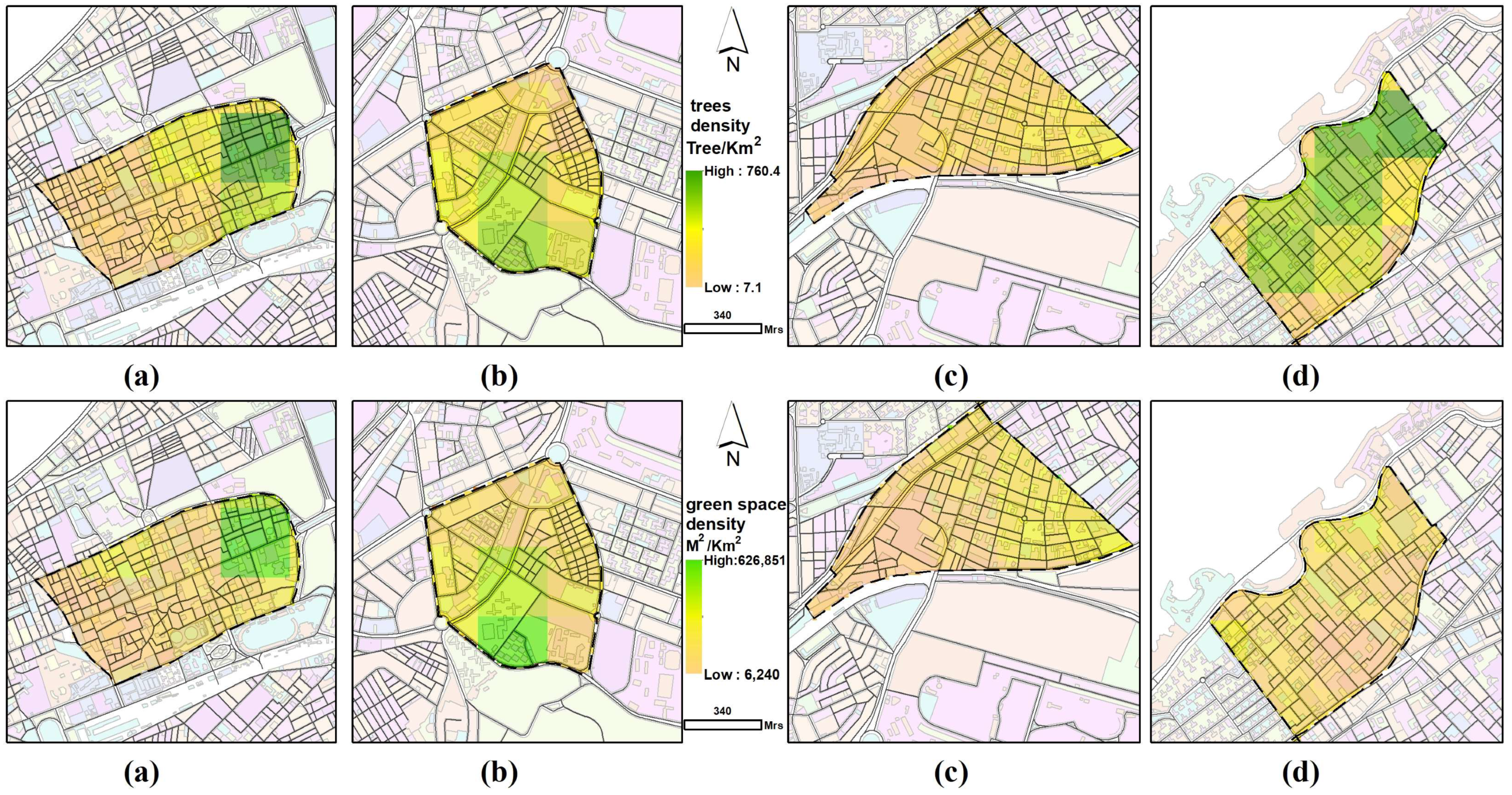


| Morphology Type | Description |
|---|---|
| Gridiron | A generic grid composed of streets and blocks; buildings are arranged in a linear pattern. |
| Radial | A radial point from which streets radiate outwards. |
| Organic | Irregular curvilinear lines often flowing with the natural landscape and topography of the area. |
| Linear | Long and narrow, mostly along coastlines and historic cities. |
| Clustered | A central point around which buildings are arranged in clusters. |
| Satellite | A group of satellite communities arranged around a central city and connected through transportation routes. |
| Megastructure | Characterized by large, self-contained structures that contain multiple functions, such as housing, commerce, and transportation. |
| Criteria | Indicators |
|---|---|
| Density | Land-use mix |
| Job/Housing Balance | |
| Distance to amenities | |
| Presence of Appropriate mixed uses | |
| Diversity of services | |
| Distance to Transit | |
| Distance to nearest Amenity | |
| Density of Terminals | |
| City transit connectivity | |
| Diversity | |
| Street Design | Presence of resting spots |
| Streets density | |
| Sidewalk Coverage | |
| Sidewalk Design | Presence of sidewalk |
| Appropriate width of sidewalk to walk with a friend | |
| Material used for sidewalk | |
| Abrupt stoppages | |
| Presence of a curb | |
| Height of a curb (ease of climbing up or down) | |
| Pathway congestion with obstacles | |
| Presence of adequate ramps and slopes | |
| Appropriate and adequate maintenance | |
| Presence or absence of resting spots | |
| Adequate lighting | |
| Street Connectivity | Intersection density |
| Roads and intersections | |
| Presence of adequate traffic lights to facilitate crossing | |
| Congestion points and traffic junctures | |
| Pedestrian Safety | Destination Accessibility |
| Absence of adequate pedestrian spaces | |
| High-speed traffic without appropriate pedestrian crossings or control | |
| Visual and acoustic pollution | |
| Green Space | Presence of shade |
| Presence of trees and landscaping | |
| Adequate space around trees to walk curbs | |
| Environmental Factors | Climate |
| Time of Day | |
| Noise Levels | |
| Level of pollutants (PM.2.5, PM 10) |
| Criteria | Indicators | Adopted or Dropped | Type of Measure |
|---|---|---|---|
| Density | Residential density * | √ | Built environment |
| Household/population density * | √ | ||
| Employment density * | × | ||
| Density of services * | √ | ||
| Density of streets * | √ | ||
| Density of terminals * | √ | ||
| Commercial and services density * | √ | ||
| Floor area ratio (FAR) * | √ | ||
| Building coverage ratio (BCR) * | √ | ||
| Diversity | Land-use diversity (level of mixed use) * | √ | |
| Job/housing balance | × | ||
| Design | Land-use mixedness * | √ | |
| Sidewalk coverage | × | ||
| Presence of sidewalk | × | ||
| Appropriate width of sidewalk to walk with a friend | × | ||
| Material used for sidewalk | × | ||
| Presence of a curb | × | ||
| Height of a curb (ease of climbing up or down) | × | ||
| Pathway congestion with obstacles | × | ||
| Presence of adequate ramps and slopes | × | ||
| The density of signaled intersections/street crossings * | × | ||
| Presence of adequate traffic lights to facilitate crossing | × | ||
| Congestion points and traffic junctures | × | ||
| Pedestrian safety | × | ||
| Green space | × | ||
| Presence of shade | × | ||
| Presence of trees and landscaping | × | ||
| Trees Density | √ | ||
| Adequate space around trees to walk curbs | × | ||
| Presence of resting spots | × | ||
| Destination Accessibility | Distance to services * | √ | |
| Distance to Transit | Transit connectivity * | × |
| Neighborhood Name | Area (m2) | District Name | Morphology Type | Characteristics/Main Features |
|---|---|---|---|---|
| Latin Quarter Neighborhood | 89,000 | Wasat (Middle) | Gridiron |
|
| Smouha Neighborhood | 90,000 | Sharq (East) | Radial |
|
| Kafr–Abdo Neighborhood | 90,000 | Sharq (East) | Organic |
|
| Roushdy Neighborhood | 88,000 | Sharq (East) | Linear |
|
| Indicator | Minimum | Maximum | Mean | Standard Deviation |
|---|---|---|---|---|
| Walkability Index | 0.142 | 0.655 | 0.264 | 0.091 |
| BCR | 0.001 | 85.744 | 61.356 | 14.614 |
| FAR | 0.007 | 873.516 | 389.061 | 131.363 |
| Level of Mixed Use | 0.037 | 0.176 | 0.068 | 0.020 |
| Land-Use Mixedness | 0.307 | 1.000 | 0.684 | 0.169 |
| Service Density | 60.125 | 735.650 | 372.137 | 124.642 |
| Commercial Density | 3.6 | 325.38 | 76.25 | 68.4 |
| Residential Density | 3.537 | 381.972 | 233.926 | 90.340 |
| Population Density | 25029 | 48730.2 | 34910.2 | 5562.7 |
| Intersection Density | 21.221 | 537.590 | 187.161 | 84.106 |
| Street Density | 9.159 | 37.253 | 26.722 | 4.475 |
| Transit Density | 0.000 | 21.221 | 3.359 | 3.893 |
| Transit Distance | 0.000 | 724.614 | 287.605 | 153.887 |
| Trees Density | 7.074 | 760.407 | 334.042 | 206.563 |
| Green Spaces Density | 6239.913 | 6850.813 | 6550.631 | 6518.649 |
| Indicators | BCR | FAR | Level of Mixed Use | Land-Use Mixedness | Service Density | Commercial Density | Residential Density | Population Density | Intersection Density | Street Density | Transit Density | Transit Distance | Trees Density | Green Spaces Density |
|---|---|---|---|---|---|---|---|---|---|---|---|---|---|---|
| Walkability index | 0.45 | −0.01 | −0.22 | 0.11 | 0.82 | 1.0 | 0.43 | 0.08 | 0.83 | 0.53 | 0.07 | −0.28 | −0.35 | −0.39 |
Disclaimer/Publisher’s Note: The statements, opinions and data contained in all publications are solely those of the individual author(s) and contributor(s) and not of MDPI and/or the editor(s). MDPI and/or the editor(s) disclaim responsibility for any injury to people or property resulting from any ideas, methods, instructions or products referred to in the content. |
© 2024 by the authors. Licensee MDPI, Basel, Switzerland. This article is an open access article distributed under the terms and conditions of the Creative Commons Attribution (CC BY) license (https://creativecommons.org/licenses/by/4.0/).
Share and Cite
Ibrahim, S.; Younes, A.; Abdel-Razek, S.A. Impact of Neighborhood Urban Morphologies on Walkability Using Spatial Multi-Criteria Analysis. Urban Sci. 2024, 8, 70. https://doi.org/10.3390/urbansci8020070
Ibrahim S, Younes A, Abdel-Razek SA. Impact of Neighborhood Urban Morphologies on Walkability Using Spatial Multi-Criteria Analysis. Urban Science. 2024; 8(2):70. https://doi.org/10.3390/urbansci8020070
Chicago/Turabian StyleIbrahim, Sara, Ahmed Younes, and Shahira Assem Abdel-Razek. 2024. "Impact of Neighborhood Urban Morphologies on Walkability Using Spatial Multi-Criteria Analysis" Urban Science 8, no. 2: 70. https://doi.org/10.3390/urbansci8020070
APA StyleIbrahim, S., Younes, A., & Abdel-Razek, S. A. (2024). Impact of Neighborhood Urban Morphologies on Walkability Using Spatial Multi-Criteria Analysis. Urban Science, 8(2), 70. https://doi.org/10.3390/urbansci8020070





